Lactation induces increased IPSC bursting in oxytocinergic neurons
- PMID: 31008554
- PMCID: PMC6475881
- DOI: 10.14814/phy2.14047
Lactation induces increased IPSC bursting in oxytocinergic neurons
Abstract
Hypothalamic magnocellular neurosecretory cells (MNCs) undergo dramatic structural reorganization during lactation in female rats that is thought to contribute to the pulsatile secretion of oxytocin critical for milk ejection. MNCs from male rats generate robust bursts of GABAergic synaptic currents, a subset of which are onset-synchronized between MNC pairs, but the functional role of the IPSC bursts is not known. To determine the physiological relevance of IPSC bursts, we compared MNCs from lactating and non-lactating female rats using whole-cell recordings in brain slices. We recorded a sixfold increase in the incidence of IPSC bursts in oxytocin (OT)-MNCs from lactating rats compared to non-lactating rats, whereas there was no change in IPSC bursts in vasopressin (VP)-MNCs. Synchronized bursts of IPSCs were observed in pairs of MNCs in slices from lactating rats. Our data indicate, therefore, that IPSC bursts are upregulated specifically in OT-MNCs during lactation, and may, therefore, contribute via rebound depolarization to the spike trains in OT neurons that lead to reflex milk ejection.
Keywords: GABA; IPSC; burst; lactation; oxytocin; synchronization.
© 2019 The Authors. Physiological Reports published by Wiley Periodicals, Inc. on behalf of The Physiological Society and the American Physiological Society.
Conflict of interest statement
None declared.
Figures
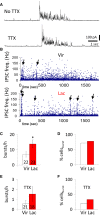
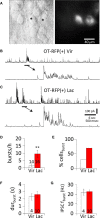
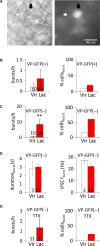
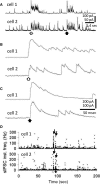
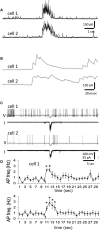

Similar articles
-
Plasticity in Intrinsic Excitability of Hypothalamic Magnocellular Neurosecretory Neurons in Late-Pregnant and Lactating Rats.Int J Mol Sci. 2021 Jul 1;22(13):7140. doi: 10.3390/ijms22137140. Int J Mol Sci. 2021. PMID: 34281190 Free PMC article.
-
GABAergic inhibition is weakened or converted into excitation in the oxytocin and vasopressin neurons of the lactating rat.Mol Brain. 2015 May 28;8:34. doi: 10.1186/s13041-015-0123-0. Mol Brain. 2015. PMID: 26017151 Free PMC article.
-
Burst firing of oxytocin neurons in male rat hypothalamic slices.Brain Res. 2005 Jan 25;1032(1-2):36-43. doi: 10.1016/j.brainres.2004.10.046. Brain Res. 2005. PMID: 15680939
-
[Control of oxytocin secretion in lactation].Nihon Naibunpi Gakkai Zasshi. 1993 May 20;69(5):520-9. doi: 10.1507/endocrine1927.69.5_520. Nihon Naibunpi Gakkai Zasshi. 1993. PMID: 8392467 Review. Japanese.
-
Plasticity in the electrophysiological properties of oxytocin neurons.Microsc Res Tech. 2002 Jan 15;56(2):73-80. doi: 10.1002/jemt.10019. Microsc Res Tech. 2002. PMID: 11810710 Review.
Cited by
-
Perinatal activation of ERα and ERβ but not GPER-1 masculinizes female rat caudate-putamen medium spiny neuron electrophysiological properties.J Neurophysiol. 2021 Jun 1;125(6):2322-2338. doi: 10.1152/jn.00063.2021. Epub 2021 May 12. J Neurophysiol. 2021. PMID: 33978486 Free PMC article.
-
Dendritic osmosensors modulate activity-induced calcium influx in oxytocinergic magnocellular neurons of the mouse PVN.Elife. 2021 Jul 12;10:e63486. doi: 10.7554/eLife.63486. Elife. 2021. PMID: 34250900 Free PMC article.
-
Oxytocin in Women's Health and Disease.Front Endocrinol (Lausanne). 2022 Feb 15;13:786271. doi: 10.3389/fendo.2022.786271. eCollection 2022. Front Endocrinol (Lausanne). 2022. PMID: 35242106 Free PMC article. Review.
-
Somato-dendritic vasopressin and oxytocin secretion in endocrine and autonomic regulation.J Neuroendocrinol. 2020 Jun;32(6):e12856. doi: 10.1111/jne.12856. Epub 2020 May 14. J Neuroendocrinol. 2020. PMID: 32406599 Free PMC article. Review.
-
Astrocytic Hydrogen Sulfide Regulates Supraoptic Cellular Activity in the Adaptive Response of Lactating Rats to Chronic Social Stress.ASN Neuro. 2021 Jan-Dec;13:17590914211043087. doi: 10.1177/17590914211043087. ASN Neuro. 2021. PMID: 34579557 Free PMC article.
References
Publication types
MeSH terms
Substances
Grants and funding
LinkOut - more resources
Full Text Sources

